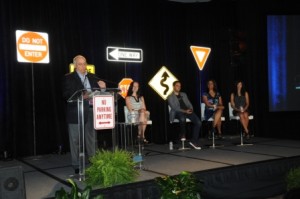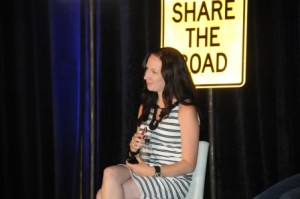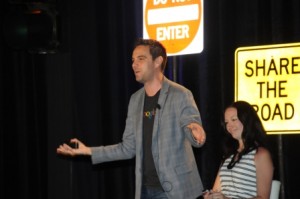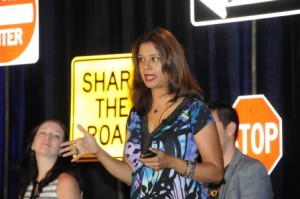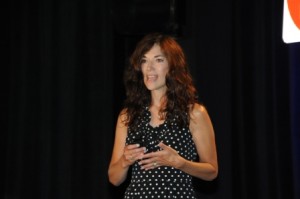In Tuesday’s General Session Luncheon sponsored by the Counselor’s Network, “PR & Big Data,” four industry experts addressed data analysis and its role in the future of public relations.
How PR pros can use the information to make better decisions has been a challenge for communication professionals. Research is an integral part of PR planning, including learning how to analyze and use big data for better public communications, understanding audience needs, and using data for competitive marketplace intelligence.
Our panel consisted of:
- Heather Whaling, President, Geben Communication
- Adam Singer, Analytics Advocate, Google Analytics
- Sonali Burke, President and CEO, Shonali Burke Consulting, Inc.
- Deirdre Breakenridge, CEO and Director of Communications, Pure Performance Communications
Heather opened the session asking attendants if they consider themselves data novices, intermediates or data geeks. Most attendees identified themselves as intermediates.
The panel shared case studies and examined how data was used to meet campaign and program objectives.
Adam discussed Google tools for PR pros. He’s been speaking at events for many years, and he’s very excited to see that in the last few years, PR pros are viewing themselves more as PR intermediates (rather than novices) with regard to analytics. He said many PR practitioners stress about data, but he says we can turn that stress into results. He hopes to inspire us to get better with data.
Adam said the two main uses of data for PR pros are decision-making with data; and storytelling. He said we all have access to so much data, we can use data combined with effective storytelling that we’re already engaged in.
Storytelling with data is how you stand out on the web, says Adam. The online dating company OK Cupid successfully used data to share dating trends, and as a result experienced viral growth, media attention and more. But, Adam says, before you get into tools and tactics, you need a plan:
- First, determine business objectives. Align your business objectives with what matters to the company. Remember that though it may not be the primary revenue driver, social media can contribute to incremental revenue.
- Define your business strategy.
- Identify your key stakeholders and create the right reports for those stakeholders. Contextualize charts and graphics and give people the information they need, custom to them.
- Categorize your channels. Have them organized in a way that shows key influence indicators.
Adam discussed several free Google tools available for PR practitioners:
- Google Analytics
- In one word…RESULTS!
- Move from campaign-thinking to ongoing data-driven optimization and steady trends upward.
- Google Analytics also can help a PR firm improve their own marketing. For example, SHIFT Communications tested a new landing page and learned earned media and offline marketing accounted for 20% of lead generation. The company added a simple form field on their website and the PR department now can take credit for the results. Remember that once you know what’s working for you, you can section it even further to deeper, more meaningful analysis. Social has a value, but you should measure it effectively.
- Understand the role of PR in the modern customer journey
- Awareness -> consideration -> intent -> decision
- PR contributes to the purchase model
- Show how PR is contributing to revenue
- Understand the role of PR in the modern customer journey
- More fully understand the full value of media generated. Google Analytics answers key questions: What sites convert best? What sites send traffic? What types of sites should we research more fully?
- Custom Dashboards
- You can share custom dashboards with team members and key stakeholders.
- Go beyond “vanity metrics” in social. PR firms have gotten into social, but few measure outcomes. Show how social contributes toward conversion.
- Break down the digital/social silo with integration.
- Make launches and events more exciting and actionable with real time. You can see real time on a mobile device with the app.
- Visualize how traffic flows through your site (behavior); see what blog posts are most popular. Work on calls to action to improve performance of Google Analytics.
- Google Databoard – Research Insights
- Use your data to power the news. Allow the news media to see you as a source.
Remember to ask the questions, “Why are we doing what we’re doing? What are our goals? Do these support our business objectives? Why spend the time doing it?”
Sonali shared with us what a lot of PR professionals are tasked with on a day-to-day level: media relations. How can we take some of our overarching media-relations ‘rules of thumb,’ and tie them back to business objectives?
Oxfam America IWD sought assistance from Sonali’s agency regarding International Women’s Day Award. She and her team asked repeatedly why they wanted the “buzz,” and what that looked like to them.
It turned out that Oxfam America had two initiatives under development: 1) E-cards to bring visitors to the website and capture email addresses, and 2) an International Women’s Day toolkit for download.
Sonali created a simple PDF of the two initiatives, and they became the two calls for action. The outreach approach included getting some ‘face time’ among mommy bloggers and the cause-passionate. Sonali and team conducted a lot of online research, tracked influence scoring platforms, and more. The firm didn’t just “spray and pray,” the news, but engaged in a multi-pronged outreach. HITS = How Idiots Track Success! So, she didn’t track hits, she tracked….
- eAwards were downloaded 1,000 times around IWD
- More than 5,000 recipients of 2,000 e-cards
- Company secured 752 new constituents via the e-cards
- They wanted people to sign up and become part of their advocacy brigade
- They found a strong correlation between blog post publishing and search traffic; 14 of 42 blog posts secured were among the top 28 traffic sources.
Deirdre Breakenridge challenged the audience to “imagine the data possibilities.” She acknowledged Public Relations practitioners talk a lot about objectives and ways to pinpoint the use of data. She challenged the audience to think more objectively about how PR can use data to communicate more effectively. She presented two case studies – one serious, one lighthearted.
Case Study: The HEROIC Project
HEROIC = hazards, emergency response, and online informal communication. The project showed the audience how to save lives and keep communities safe.
The HEROIC Project was a collaborative effort with researchers from the University of Colorado and UC at Irvine. The project was created to better understand the dynamics of informal online communication in response to extreme events. The project’s aim was to protect and save lives, and afterward – before and when the next incident happens – learn what the players can do better.
The HEROIC project Deirdre discussed was the Boston Bombings. She presented a graph that depicted how different responding organizations were connected and who was following who, particularly in the Twittersphere. The nodes of the graph (the connecting dots) flashed when active, or became larger when activity increased, signifying more shares/retweets.
Deirdre noted that something as simple as a jump in followers showed the responders that in the beginning, the PIO was the most valuable source of information in this crisis. The PIO’s job was to make sure her information was getting out. Further, a significant jump in user activity (retweets) happened when significant police activity occurred during the post-bombing (captures suspect, etc.).
Social media showed that the local following online was the most significant of all. Follower behavior illuminated how and from whom they took their information.
Imagine the possibilities of Twitter during a hazardous event, said Deirdre. Twitter analysis can reveal the details of the activities and how you can apply new process in the event of the next.
Case Study: Kingsford Charcoal
The company was looking to increase its sales during a typically slower season (winter/holiday) and played with the typical “coal for Christmas” messaging most hear around that time of year. They decided to use this tradition to their advantage by searching for the “Nicest Person on Social Media.”
The company tweeted: Tweet #BeNiceGetCoal” for your chance to win a year’s supply of charcoal. They created an algorithm that searched for those who say ‘please’ and ‘thank you,’ who’s not cursing, and who had ‘grilling’ in their profile. It turned out to be a gentleman in Wisconsin!
There was PR value with the story, and the company further promoted the story on social media. They event went for round two, giving away another year of free charcoal and a free grill to a second lucky winner.
Deirdre encouraged the audience to use social media tools to get creative. Know enough about your followers/customers to be able to serve them in a better way.
Audience questions for the panel:
Q: Is there a way to measure offline Google Analytics (GA) for TV/Radio?
A: Adam: Yes. The newest version of GA uses ‘Universal Analytics.’ If it has an internet connection, you can measure it. You can measure anything you can connect to the internet. You also can assign a Unique Identifier in GA and link it to an offline sales force, etc. Heather: Assign unique URLs (landing pages) to offline tactics, such as printed pieces.
Q: Regarding the “Nicest person on social media” campaign…How do we do that kind of analysis on the cheap, such as when you work for a nonprofit or government agency and budgets are more limited?
A: Dierdre: Not everyone has the budget, but look at how you would go about using free tools. Social mention (a free tool) allows you to set up searches in social media. And, free tools have been created for Twitter as well. Be more careful about the filtering of information, too. Be aware, however, that it may take more internal resources to filter to something more accurately. If you’re doing a simple contest on Twitter, you can use a unique hashtag, and there are a number of randomizer tools you can use to pick a winner (for fairness). Sonali: Visit a blog called Razor Social, written by Ian Cleary out of Irelend. He does a lot of reviews and analyses of tools. Use the ‘simply measures’ suite, and customize it according to keywords or phrases. Also consider using Brand24.net; it’s relatively low-cost. But, try to get over the idea that things are free. Nothing in this world is free. You may spend more in time than the right tool would have cost!
Q: Tell us more about Google Premium.
A: Adam: GA premium is our enterprise solution for $150,000/year flat rate. You’ll receive an account manager, white list access to early features. Or, for more limited budgets or if you’re a nonprofit, find a local certified analyst to help for help in exchange for social mention. They often are willing to help.
Q: Of the different Google tools, how do you determine the one to focus on?
A: Adam: Focus on processes your company wants. Pushing for more leads? Use AdWords. What is your strategy? When you have your strategy, know what you want to accomplish. Think about tools and tactics last. Deirdre: What is it you’re trying to achieve? How can we track our progress? What do we need to help us determine whether we are moving the needle in the right direction? Sometimes we get lost in measuring the tool and not our end result ware trying to achieve.
Q: How do we know our Google data is safe? All the concerns about NSA…
A: Adam: Your data is yours. You can take it out of our servers whenever you want. We can’t even look at your data. From a broader perspective, the tech industry does not want to share data with the government. It’s a breach of trust for us. It’s bad for the entire tech world.
 ABOUT HEATHER WHALING
ABOUT HEATHER WHALING
Heather Whaling is president of a small PR consultancy, Geben Communications. She has been named one of the top 30 PR experts to follow on Twitter and has been quoted in Inc. Magazine, BusinessWeek and a number of industry publications about technology’s impact on communication and business. She co-moderates the popular PR 2.0 chat (#pr20chat on Twitter), a weekly exploration of social media’s influence on PR. Whaling also has a blog about PR, social media and related topics at prtini.com.
 ABOUT ADAM SINGER
ABOUT ADAM SINGER
Adam Singer is analytics advocate at Google, a marketing, media and PR industry speaker, startup adviser and blogger. He was previously digital director for a 300+ person global consulting team, and over the course of his career has provided online marketing strategy for B2B & B2C brands in a variety of industries including marketing technology, healthcare, manufacturing, advertising/subscription-based web startups and much in between. Singer and his campaigns have been cited by top media outlets such as TechCrunch, AdWeek, NY Times and more for creative use of digital marketing and PR. Singer blogs at The Future Buzz – an award winning blog with more than 25,000 subscribers and a frequently referenced source of what’s new in digital marketing.
 ABOUT SHONALI BURKE
ABOUT SHONALI BURKE
Shonali Burke is the IABC-accredited, award-winning president and CEO of Shonali Burke Consulting, Inc., where she uses her signature blend of measureable “social PR” to help you join your online flock for better business results. Her career to date has seen Burke launch landmark entertainment events, for the likes of Cirque du Soleil and Russell Simmons; lead communication for the ASPCA, including through the 2007 pet food recall and Michael Vick case; and give refugees a voice, both online and off, via USA for UNHCR’s Blue Key campaign. In 2007, PRWeek recognized Burke as one of the top 40 Under 40 professionals in the US. She has been named one of 100 PR Pros Worth Following on Twitter, one of 25 Women Who Rock Social Media and was featured at TEDxAdamsMorganWomen in December 2012.
 ABOUT DEIRDRE BREAKENRIDGE
ABOUT DEIRDRE BREAKENRIDGE
Deirdre Breakenridge is chief executive officer at Pure Performance Communications. A veteran in PR and marketing, Breakenridge has counseled senior-level executives at companies including the Academy of Nutrition and Dietetics, Empire Today, Hershey’s, JVC, Kraft and the World Bank. She’s also the author of five Financial Times books. Her most recent book, “Social Media and Public Relations: Eight New Practices for the PR Professional,” was published in May 2012 and is available in print and all digital formats. Her other books include, “Putting the Public Back in Public Relations,” “PR 2.0, New Media, New Tools, New Audiences,” “The New PR Toolkit” and “Cyberbranding: Brand Building in the Digital Economy.” Breakenridge blogs about PR 2.0 strategies and is the co-founder of #PRStudChat, a dynamic Twitter discussion scheduled monthly for PR students, educators and PR pros.

